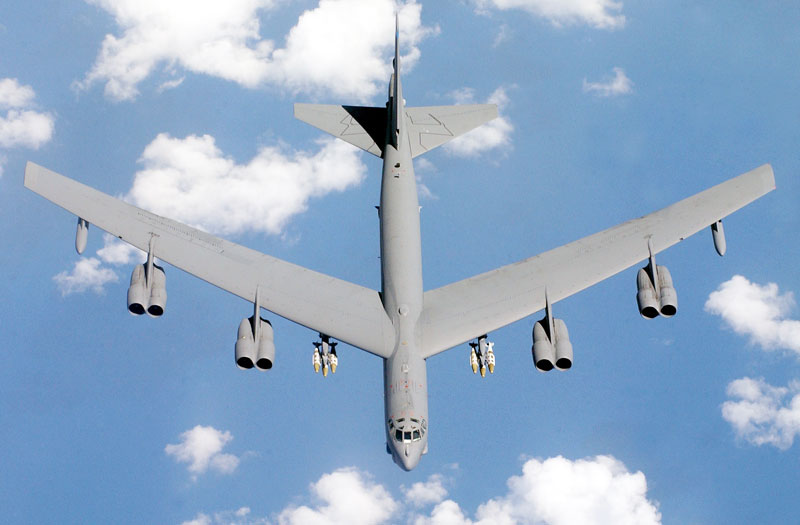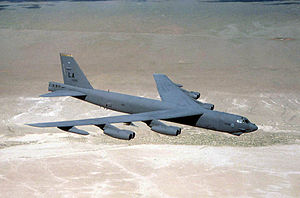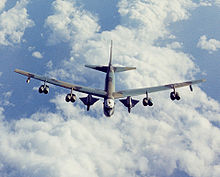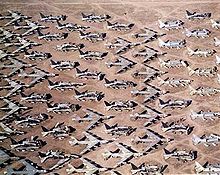












| Medium Bombers |
| Heavy Bombers |
| Torpedo Bombers |
| Dive Bombers |
| B-1 Lancer |  |
| B-2 Spirit |  |
| B-52H Stratofortress | 
|
| Canberra |  |
| Mirage IV |  |
| F-111 |  |
| IL-28 Beagle |  |
| SU-24 Fencer |  |
| TU-16 Badger |  |
| TU-160 Blackjack |  |
| TU-22 Blinder |  |
| TU-22M Backfire |  |
| TU-95 Bear |  |

|
 A B-52H from Barksdale AFB flying over the desert |
 B-52H modified to carry two D-21 drones |
 Retired B-52s are stored at the 309th AMARG (formerly AMARC), a desert storage facility often called the "Boneyard" at Davis-Monthan AFB near Tucson, Arizona. |
| Crew Positions (6) : | - all in ejection seats Aircraft Commander Pilot Radar Navigator Navigator Electronic Warfare Officer (ECM) Former Gunner's Position Provisions for Additional Crew Positions (4) - no ejection seats Instructor Pilot Instructor Navigator Instructor Electronic Warfare Officer (ECM) Instructor Gunner |
| Crew: | five (aircraft commander, pilot, radar navigator, navigator and electronic warfare officer) |
| Primary function: | heavy bomber |
| Power plant: | Eight Pratt & Whitney engines TF33-P-3/103 turbofan |
| Thrust: | each engine up to 17,000 pounds |
| Length: | 159 feet, 4 inches (48.5 meters) |
| Height: | 40 feet, 8 inches (12.4 meters) |
| Weight: | Approximately 185,000 pounds (83,250 kilograms) |
| Maximum takeoff weight: | 488,000 pounds (219,600 kilograms) |
| Fuel Capacity: | 312,197 pounds (141,610 kilograms) |
| Fuel Capacity: | 48,000 gallons |
| Payload: | 70,000 pounds (31,500 kilograms) |
| Speed: | 650 miles per hour (Mach 0.84) |
| Range (unrefuled): | 8,800 miles (7,652 nautical miles) |
| Ceiling: | 50,000 feet (15,151.5 meters) |
| Armament: | approximately 70,000 pounds (31,500 kilograms) mixed ordnance -- bombs, mines and missiles. (modified to carry air-launched cruise missiles) |
| Initial operating capability: | April 1952 |
| Inventory: | active force, 58; ANG, 0; Reserve, 18 |
| Wingspan: | 185 feet (56.4 meters) |
|
In the early days of the Great War, the bomber was a relatively new concept. Like all Great War era aircraft, it had many problems, the majority of them crippling. As Canadian ace Billy Bishop once stated: "They gave us these bombs, and told us to drop them on someone". Early bombing was a very archaic practice. Rickety biplanes were not strong enough to hold bombs underwing until later on in time. Sometimes, the sheer weight of the bombs prevented the planes from even getting off the ground, and in order to accommodate the bombs, instruments, or even the invaluable machine guns, might be removed. The pilot would have to load his bombs, fly to his target, and throw them out of the plane, guiding them to their target with equal measures luck and prayer. As one could expect, this form of bombing never made a significant dent in the war machines of the Allies or the Entente. It did provide pilots, however, with valuable lessons on the art of bombing. Advantages of bombing •Deadly psychological warfare. Infrequent raids frightened civilians, as they had no idea when the bombers were coming, the damage they would inflict, and who would be killed. •Allowed for targets out of the reach of artillery or ground forces to be strafed or destroyed. •Huge amounts of damage could be inflicted upon targets. •Bombers could be modified to assume a wide variety of roles. Disadvantages of bombing •Frequent bombing sometimes ceased to have a terrifying psychological effect on the victims. In the battle of Britain, London bombings became as normal as the weather, and in certain cases, civilians even went about their daily routine during raids. In plainer speech, bombing victims sometimes gained morale as opposed to losing it. •Civilian casualties are impossible to avoid. •Bombers are vulnerable to attack, and the rise of the interceptor in the 1960's proved that one does not need to see his enemy to engage it. •Bombers are extremely expensive to build, expensive to maintain, and very vulnerable to interceptors and missiles. |